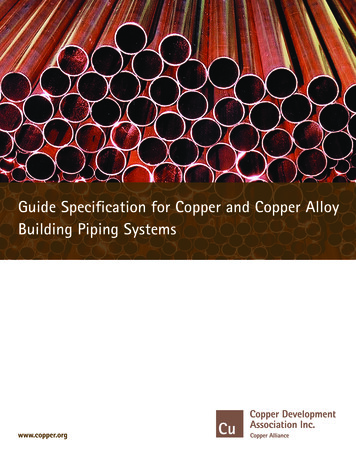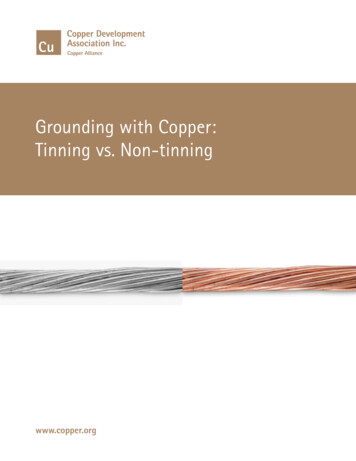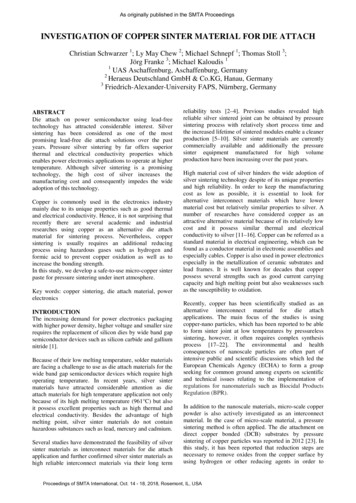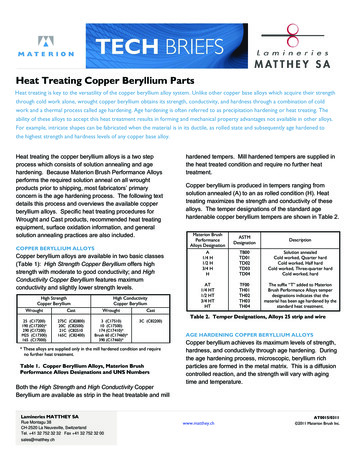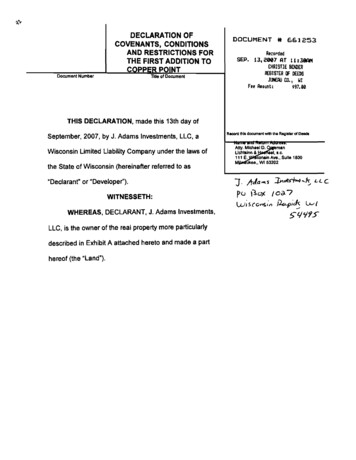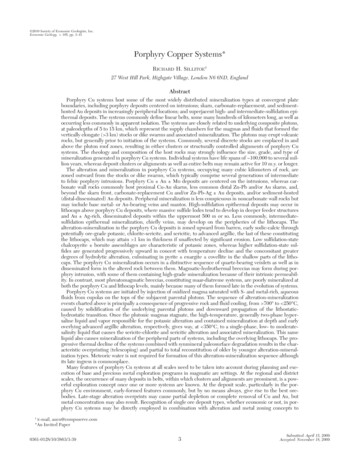
Transcription
2010 Society of Economic Geologists, Inc.Economic Geology, v. 105, pp. 3–41Porphyry Copper Systems*RICHARD H. SILLITOE†27 West Hill Park, Highgate Village, London N6 6ND, EnglandAbstractPorphyry Cu systems host some of the most widely distributed mineralization types at convergent plateboundaries, including porphyry deposits centered on intrusions; skarn, carbonate-replacement, and sedimenthosted Au deposits in increasingly peripheral locations; and superjacent high- and intermediate-sulfidation epithermal deposits. The systems commonly define linear belts, some many hundreds of kilometers long, as well asoccurring less commonly in apparent isolation. The systems are closely related to underlying composite plutons,at paleodepths of 5 to 15 km, which represent the supply chambers for the magmas and fluids that formed thevertically elongate ( 3 km) stocks or dike swarms and associated mineralization. The plutons may erupt volcanicrocks, but generally prior to initiation of the systems. Commonly, several discrete stocks are emplaced in andabove the pluton roof zones, resulting in either clusters or structurally controlled alignments of porphyry Cusystems. The rheology and composition of the host rocks may strongly influence the size, grade, and type ofmineralization generated in porphyry Cu systems. Individual systems have life spans of 100,000 to several million years, whereas deposit clusters or alignments as well as entire belts may remain active for 10 m.y. or longer.The alteration and mineralization in porphyry Cu systems, occupying many cubic kilometers of rock, arezoned outward from the stocks or dike swarms, which typically comprise several generations of intermediateto felsic porphyry intrusions. Porphyry Cu Au Mo deposits are centered on the intrusions, whereas carbonate wall rocks commonly host proximal Cu-Au skarns, less common distal Zn-Pb and/or Au skarns, and,beyond the skarn front, carbonate-replacement Cu and/or Zn-Pb-Ag Au deposits, and/or sediment-hosted(distal-disseminated) Au deposits. Peripheral mineralization is less conspicuous in noncarbonate wall rocks butmay include base metal- or Au-bearing veins and mantos. High-sulfidation epithermal deposits may occur inlithocaps above porphyry Cu deposits, where massive sulfide lodes tend to develop in deeper feeder structuresand Au Ag-rich, disseminated deposits within the uppermost 500 m or so. Less commonly, intermediatesulfidation epithermal mineralization, chiefly veins, may develop on the peripheries of the lithocaps. Thealteration-mineralization in the porphyry Cu deposits is zoned upward from barren, early sodic-calcic throughpotentially ore-grade potassic, chlorite-sericite, and sericitic, to advanced argillic, the last of these constitutingthe lithocaps, which may attain 1 km in thickness if unaffected by significant erosion. Low sulfidation-statechalcopyrite bornite assemblages are characteristic of potassic zones, whereas higher sulfidation-state sulfides are generated progressively upward in concert with temperature decline and the concomitant greaterdegrees of hydrolytic alteration, culminating in pyrite enargite covellite in the shallow parts of the lithocaps. The porphyry Cu mineralization occurs in a distinctive sequence of quartz-bearing veinlets as well as indisseminated form in the altered rock between them. Magmatic-hydrothermal breccias may form during porphyry intrusion, with some of them containing high-grade mineralization because of their intrinsic permeability. In contrast, most phreatomagmatic breccias, constituting maar-diatreme systems, are poorly mineralized atboth the porphyry Cu and lithocap levels, mainly because many of them formed late in the evolution of systems.Porphyry Cu systems are initiated by injection of oxidized magma saturated with S- and metal-rich, aqueousfluids from cupolas on the tops of the subjacent parental plutons. The sequence of alteration-mineralizationevents charted above is principally a consequence of progressive rock and fluid cooling, from 700 to 250 C,caused by solidification of the underlying parental plutons and downward propagation of the lithostatichydrostatic transition. Once the plutonic magmas stagnate, the high-temperature, generally two-phase hypersaline liquid and vapor responsible for the potassic alteration and contained mineralization at depth and earlyoverlying advanced argillic alteration, respectively, gives way, at 350 C, to a single-phase, low- to moderatesalinity liquid that causes the sericite-chlorite and sericitic alteration and associated mineralization. This sameliquid also causes mineralization of the peripheral parts of systems, including the overlying lithocaps. The progressive thermal decline of the systems combined with synmineral paleosurface degradation results in the characteristic overprinting (telescoping) and partial to total reconstitution of older by younger alteration-mineralization types. Meteoric water is not required for formation of this alteration-mineralization sequence althoughits late ingress is commonplace.Many features of porphyry Cu systems at all scales need to be taken into account during planning and execution of base and precious metal exploration programs in magmatic arc settings. At the regional and districtscales, the occurrence of many deposits in belts, within which clusters and alignments are prominent, is a powerful exploration concept once one or more systems are known. At the deposit scale, particularly in the porphyry Cu environment, early-formed features commonly, but by no means always, give rise to the best orebodies. Late-stage alteration overprints may cause partial depletion or complete removal of Cu and Au, butmetal concentration may also result. Recognition of single ore deposit types, whether economic or not, in porphyry Cu systems may be directly employed in combination with alteration and metal zoning concepts to† E-mail,aucu@compuserve.com*An Invited Paper0361-0128/10/3863/3-393Submitted: April 15, 2009Accepted: November 18, 2009
4RICHARD H. SILLITOEsearch for other related deposit types, although not all those permitted by the model are likely to be present inmost systems. Erosion level is a cogent control on the deposit types that may be preserved and, by the sametoken, on those that may be anticipated at depth. The most distal deposit types at all levels of the systems tendto be visually the most subtle, which may result in their being missed due to overshadowing by more prominent -sulfidation epithermal Au Ag Cu orebodies( 1 Mt 1 Gt). Porphyry Cu systems were generated worldwide since the Archean, although Meso-Cenozoic examplesare most abundantly preserved (e.g., Singer et al., 2008; Fig.1), probably because younger arc terranes are normally theleast eroded (e.g., Seedorff et al., 2005; Kesler and Wilkinson,2006; Wilkinson and Kesler, 2009).Porphyry Cu systems presently supply nearly three-quarters of the world’s Cu, half the Mo, perhaps one-fifth of theAu, most of the Re, and minor amounts of other metals (Ag,Pd, Te, Se, Bi, Zn, and Pb). The systems also contain majorresources of these metals as well as including the world’slargest known exploitable concentrations of Cu (203 Mt: LosBronces-Río Blanco, central Chile; A.J. Wilson, writ. commun., 2009) and Mo (2.5 Mt: El Teniente, central Chile;Camus, 2003), and the second largest of Au (129 Moz: Grasberg, including contiguous skarn, Indonesia; J. MacPherson,PORPHYRY Cu systems are defined as large volumes (10 100km3) of hydrothermally altered rock centered on porphyry Custocks that may also contain skarn, carbonate-replacement,sediment-hosted, and high- and intermediate-sulfidation epithermal base and precious metal mineralization. Along withcalc-alkaline batholiths and volcanic chains, they are the hallmarks of magmatic arcs constructed above active subductionzones at convergent plate margins (Sillitoe, 1972; Richards,2003), although a minority of such systems occupies postcollisional and other tectonic settings that develop after subduction ceases (e.g., Richards, 2009). The deeper parts of porphyry Cu systems may contain porphyry Cu Mo Audeposits of various sizes ( 10 million metric tons [Mt]-10 billion metric tons [Gt]) as well as Cu, Au, and/or Zn skarns ( 1Mt 1 Gt), whereas their shallower parts may host high- andGalore CreekPebbleMt PolleyRecskHighland Valley dist.Rosia PoieniBinghamIsland CopperAlmalykOyu TolgoiKounradButteMajdanpekTinticYeringtonPueblo ViejoGlobeMiamiRayMineral ParkSaindakCananeaCopper nta Rita(Central dist.)YanacochaAntaminaBisbeeSanto Tomas II &Nugget HillDizonBoyongan-BayugoSar CheshmehTampakanMorenciResolution(Superior dist.)Lepanto & Guinaoang(Mankayan dist.)Reko DiqCotabambasToquepala &CuajoneLos PelambresLos BroncesRío BlancoEl TenienteMamutGrasberg-ErtsbergOk TediCerro de Pasco& ColquijircaChoquelimpieEsperanzaEscondida &ChimborazoPangunaCerro ColoradoCollahuasi dist.BauBatu HijauEl AbraCabang KiriChuquicamata dist.KoloulaFrieda River dist.(Nena)Wafi-GolpuGabyEl SalvadorPotrerillosMarte &CaspicheTaca Taca BajoBajo de la Alumbrera (Farallón Negro dist.) & Agua RicaNevados del FamatinaNorthparkesPascua-Lama & VeladeroAndacolloPrincipal metalsCu-MoCu-Mo-AuCu-AuAg-Pb-Zn-CuNo porphyry knownDeposit typePorphyryPorphyry major skarn/carbonate replacementHigh-sulfidationepithermal porphyryBauGabyRayBisbeeOyuT te Cretaceous-PaleoceneLate Triassic-Early CretaceousLate Devonian-CarboniferousOrdovicianFIG. 1. Worldwide locations of porphyry Cu systems cited as examples of features discussed in the text along with five additional giant examples. The principal deposit type(s), contained metals, and age are also indicated. Data mainly from sourcescited in the text.0361-0128/98/000/000-00 6.004Cadia
5PORPHYRY COPPER SYSTEMSwrit. commun., 2009). Typical hypogene porphyry Cu deposits have average grades of 0.5 to 1.5 percent Cu, 0.01 to0.04 percent Mo, and 0.0 to 1.5 g/t Au, although a few “Auonly” deposits have Au tenors of 0.9 to 1.5 g/t but little Cu( 0.1 %). The Cu and, in places, Au contents of skarns aretypically higher still. In contrast, large high-sulfidation epithermal deposits average 1 to 3 g/t Au but have only minor orno recoverable Cu, commonly as a result of supergeneremoval.This field-oriented article reviews the geology of porphyryCu systems at regional, district, and deposit scales. The resultant geologic model is then used as the basis for a brief synthesis of porphyry Cu genesis and discussion of explorationguidelines. The deposits and prospects used as examplesthroughout the text are located and further characterized inFigure 1. The economically important results of supergeneoxidation and enrichment in porphyry Cu systems have beenaddressed elsewhere (Sillitoe, 2005, and references therein).72 68 PERU18 ARICABOLIVIACollahuasiChuquicamataEl Abra22 AALCMEALTORegional- and District-Scale Characteristics0361-0128/98/000/000-00 6.00ROANTOFAGASTABelts and provincesPorphyry Cu systems show a marked tendency to occur inlinear, typically orogen-parallel belts, which range from a fewtens to hundreds and even thousands of kilometers long, asexemplified by the Andes of western South America (Sillitoeand Perelló, 2005; Fig. 2) and the Apuseni-Banat-TimokSrednogorie belt of Romania, Serbia, and Bulgaria (Janković,1977; Popov et al., 2002). Deposit densities commonly attain15 per 100,000 km2 of exposed permissive terrane (Singer etal., 2005). Each belt corresponds to a magmatic arc of broadlysimilar overall dimensions. One or more subparallel beltsconstitute porphyry Cu or epithermal Au provinces, several ofwhich give rise to global-scale anomalies for Cu (e.g., northern Chile-southern Peru, southwestern North America) or Au(northern Peru; Sillitoe, 2008). Notwithstanding the ubiquityof porphyry Cu belts, major deposits may also occur in isolation or at least as distant outliers of coherent belts andprovinces (e.g., Pebble in Alaska, Butte in Montana, andBingham in Utah; Sillitoe, 2008; Fig. 1). Pueblo Viejo in theDominican Republic (Fig. 1) is the best example of a major,isolated high-sulfidation epithermal Au deposit, albeit with nocurrently known porphyry Cu counterpart.Porphyry Cu belts developed during well-defined metallogenic epochs, which isotopic dating shows to have typical durations of 10 to 20 m.y. Each porphyry Cu epoch is closelylinked to a time-equivalent magmatic event. Again, the Andes(Sillitoe and Perelló, 2005), southwestern North America (Titley, 1993; Barra et al., 2005), and Apuseni-Banat-TimokSrednogorie belt (Zimmerman et al., 2008) provide prime examples. Individual porphyry Cu belts are commonly spatiallyseparate rather than superimposed on one another, reflectingarc migration as a result of steepening or shallowing of subducted slabs between the individual magmatic-metallogenicepochs (e.g., Sillitoe and Perelló, 2005). The processes of subduction erosion and terrane accretion at convergent marginsmay assist with land- or trenchward migration of the arcs andcontained porphyry Cu belts (e.g., von Huene and Scholl,1991; Kay et al., 2005). Nevertheless, several temporallydiscrete porphyry Cu-bearing arcs may be superimposed onAREscondidaCHIBARCA26 El SalvadorPotrerillosCOPIAPÓARGENTINALA SERENA30 LineamentFaultPorphyry CudepositSANTIAGO100kmFIG. 2. A preeminent example of spatial and temporal coincidence between a porphyry Cu belt and an intra-arc fault zone: the northern Chile partof the central Andean middle Eocene to early Oligocene porphyry Cu beltand Domeyko fault system (summarized from Sillitoe and Perelló, 2005).The apparent termination of the belt in northernmost Chile is a result of concealment beneath Miocene volcanic rocks. Approximate positions of themain arc-transverse lineaments in northern Chile are also shown (after Salfity, 1985, in Richards et al., 2001).5
6RICHARD H. SILLITOEone another: five since 45 Ma in the Chagai belt, Pakistan(Perelló et al., 2008).much wider (160 km) Texas lineament of southwestern NorthAmerica (Schmitt, 1966) being oft-quoted examples. Thesetransverse features, possibly reflecting underlying basementstructures, may facilitate ascent of the relatively small magmavolumes involved in porphyry Cu systems (e.g., Clark, 1993;Richards, 2000).Tectonic settingsPorphyry Cu systems are generated mainly in magmatic arc(including backarc) environments subjected to a spectrum ofregional-scale stress regimes, apparently ranging from moderately extensional through oblique slip to contractional (Tosdal and Richards, 2001). Strongly extensional settings, typified by compositionally bimodal basalt-rhyolite magmatism,lack significant porphyry Cu systems (Sillitoe, 1999a; Tosdaland Richards, 2001). The stress regime depends, amongother factors, on whether there is trench advance or rollbackand the degree of obliquity of the plate convergence vector(Dewey, 1980).Nevertheless, there is a prominent empirical relationshipbetween broadly contractional settings, marked by crustalthickening, surface uplift, and rapid exhumation, and large,high-grade hypogene porphyry Cu deposits, as exemplified bythe latest Cretaceous to Paleocene (Laramide) province ofsouthwestern North America, middle Eocene to earlyOligocene (Fig. 2) and late Miocene to Pliocene belts of thecentral Andes, mid-Miocene belt of Iran, and Pliocene beltsin New Guinea and the Philippines (Fig. 1; Sillitoe, 1998; Hillet al., 2002; Perelló et al., 2003a; Cooke et al., 2005; Rohrlachand Loucks, 2005; Sillitoe and Perelló, 2005; Perelló, 2006).Large, high-sulfidation epithermal Au deposits also form insimilar contractional settings at the tops of tectonically thickened crustal sections, albeit not together with giant porphyryCu deposits (Sillitoe and Hedenquist 2003; Sillitoe, 2008). Itmay be speculated that crustal compression aids developmentof large mid- to upper-crustal magma chambers (Takada,1994) capable of efficient fractionation and magmatic fluidgeneration and release, especially at times of rapid uplift anderosional unroofing (Sillitoe, 1998), events which maypresage initiation of stress relaxation (Tosdal and Richards,2001; Richards, 2003, 2005; Gow and Walshe, 2005). Changesin crustal stress regime are considered by some as especiallyfavorable times for porphyry Cu and high-sulfidation epithermal Au deposit generation (e.g., Tosdal and Richards,2001), with Bingham and Bajo de la Alumbrera, Argentina,for example, both apparently occupying such a tectonic niche(Presnell, 1997; Sasso and Clark, 1998; Halter et al., 2004; Sillitoe, 2008).Faults and fault intersections are invariably involved, togreater or lesser degrees, in determining the formational sitesand geometries of porphyry Cu systems and their constituentparts. Intra-arc fault systems, active before as well as duringmagmatism and porphyry Cu generation, are particularly important localizers, as exemplified by the Domeyko fault system during development of the preeminent middle Eoceneto early Oligocene belt of northern Chile (Sillitoe and Perelló,2005, and references therein; Fig. 2). Some investigators emphasize the importance of intersections between continentscale transverse fault zones or lineaments and arc-parallelstructures for porphyry Cu formation, with the Archibarcaand Calama-El Toro lineaments of northern Chile (Richardset al., 2001; Fig. 2), the Lachlan Transverse Zone of NewSouth Wales (Glen and Walshe, 1999), comparable featuresin New Guinea (Corbett, 1994; Hill et al., 2002), and the0361-0128/98/000/000-00 6.00Deposit clusters and alignmentsAt the district scale, porphyry Cu systems and their contained deposits tend to occur as clusters or alignments thatmay attain 5 to 30 km across or in length, respectively. Clusters are broadly equidimensional groupings of deposits (e.g.,Globe-Miami district, Arizona; Fig. 3a), whereas alignmentsare linear deposit arrays oriented either parallel or transverse to the magmatic arcs and their coincident porphyry Cubelts. Arc-parallel alignments may occur along intra-arcfault zones, as exemplified by the Chuquicamata district,northern Chile (Fig. 3b) whereas cross-arc fault zones or lineaments control arc-transverse alignments, as in the Cadia,New South Wales (Fig. 3c) and Oyu Tolgoi, Mongolia districts (Fig. 3d).Irrespective of whether the porphyry Cu systems and contained deposits define clusters or alignments, their surfacedistributions are taken to reflect the areal extents of eitherunderlying parental plutons or cupolas on their roofs. Withinthe clusters and alignments, the distance (100s 1,000s m) between individual deposits (e.g., Sillitoe and Gappe, 1984) andeven their footprint shapes can vary greatly, as observed in theChuquicamata and Cadia districts (Fig. 3b, c).Clusters or alignments of porphyry Cu systems can displaya spread of formational ages, which attain as much as 5 m.y.in the Chuquicamata (Ballard et al., 2001; Rivera and Pardo,2004; Campbell et al., 2006) and Yanacocha districts (Longoand Teal, 2005) but could be as much as 18 m.y. in the Cadiadistrict (Wilson et al., 2007). This situation implies that theunderlying parental plutons have protracted life spans, albeitintermittent in some cases, with porphyry Cu formation taking place above them at different places over time.Pluton-porphyry relationshipsVaried relationships are observed between porphyry Cusystems and precursor plutons, which are typically multiphase, equigranular intrusions, commonly of batholithic dimensions and dioritic to granitic compositions; they are notonly spatially, but also temporally and probably genetically related to porphyry Cu and superjacent epithermal Au formation (Fig. 4). The precursor plutons may act as hosts to a single deposit, as at Mount Polley, British Columbia (Fraser etal., 1995); an alignment of coalesced deposits, as in the LosBronces-Río Blanco district (Fig. 5a); or clusters of two ormore discrete deposits, as in the El Abra intrusive complex,northern Chile (Fig. 5b) and Guichon Creek batholith, Highland Valley district, British Columbia (Fig. 5c). The precursorplutons and porphyry Cu stocks are typically separated bytime gaps of 1 to 2 m.y. or less (e.g., Dilles and Wright, 1988;Casselman et al., 1995; Mortensen et al., 1995; Dilles et al.,1997; Deckart et al., 2005; Campbell et al., 2006). Many porphyry Cu systems, particularly those that are only shallowlyexposed, lack known precursor plutons, probably becausethey lie at inaccessible depths (Fig. 4).6
7bNCopper CitiesDiamond HPintoValley510.000110 45’aWest FaultPORPHYRY COPPER SYSTEMSNRT7.540.000InspirationCastleDomeMiami MiamiEastGLOBEMIAMIBlue BirdOxhideCactusCarlottaChuquicamata5km33 20Mina SurPorphyry Cu depositSkarn magnetite-Cu-Au depositExotic (supergene) Cu depositMMQuetenaGenovevaPostmineral faultTrend of magmatic arc7.520.000OpacheTownTokiMiranda5kmCALAMA686000 EcCadiaRidgewaydNBigCadia106.85 EUlanKhud(prospect)NCadiaQuarryCadiaHillHugo DummettLittleCadiaCentral6296000 N43 NCadia East Far EastSouthwest& South?1kmHeruga5kmFIG. 3. Examples of porphyry Cu clusters and alignments of various sizes and at different orientations with respect to theaxes of contemporaneous magmatic arcs. a. Globe-Miami district cluster, Arizona within the Late Cretaceous-early Tertiary(Laramide) arc (after Creasey, 1980), with the spatial distribution partially the result of mid-Tertiary extensional tectonism(Wilkins and Heidrick, 1995; Seedorff et al., 2008). b. Chuquicamata district, northern Chile aligned parallel to the middleEocene-early Oligocene arc axis (after Rivera and Pardo, 2004; S. Rivera, writ. commun., 2009), with the spatial distributionpossibly partly the result of postmineral sinistral strike-slip faulting (Brimhall et al., 2006). c. Cadia district, New South Wales,Australia, aligned oblique to the Ordovician arc axis (after Holliday et al., 2002). d. Oyu Tolgoi district, Mongolia alignednearly perpendicular to the Late Devonian arc axis (after Khashgerel et al., 2008). Porphyry Cu and other deposit outlinesprojected to surface where unexposed. Note scale difference between c and a, b, and d.0361-0128/98/000/000-00 6.007
8RICHARD H. SILLITOELimit of lithocapBase phyryCu stock 5kmv5kmLate-mineralPorphyryIntermineral stockEarlyParental plutonCompositeprecursorplutonvvComagmaticvolcanic rocksSubvolcanicbasementFIG. 4. Spatial relationships between porphyry Cu stocks, underlying pluton, overlying comagmatic volcanic rocks, andthe lithocap. The precursor pluton is multiphase, whereas the parental pluton is shown as a single body in which the concentric dotted lines mark its progressive inward consolidation. The early, intermineral, and late-mineral phases of the porphyry Cu stocks, which span the interval during which the porphyry Cu deposits formed, originate from increasingly greaterdepths in the progressively crystallizing parental chamber. The volcanic sequence is a stratovolcano (but could just as readily be a dome complex; Fig. 6) and has been partly eroded prior to porphyry Cu formation. The lithocap affects the volcanicpile as well as uppermost parts of the underlying rocks. Note that subvolcanic basement rocks host much of the porphyry Cudeposit on the left, whereas that on the right is mainly enclosed by two phases of the precursor pluton. Inspired by Sillitoe(1973), Dilles (1987), Tosdal and Richards (2001), Casselman et al. (1995), and Dilles and Proffett (1995).The precursor plutons are considered as the mid- to uppercrustal crystallization sites of mafic to felsic magmas that ascended from deeper reservoirs before porphyry Cu systemswere developed (see Richards, 2003). Outcropping precursorplutons normally represent the shallower, earlier consolidatedparts rather than the magma volumes from which the fluidsfor porphyry Cu generation were derived (Fig. 4). Theseparental magma chambers, also represented by similarequigranular to weakly porphyritic plutons, are not exposed inporphyry Cu systems unless postmineralization extensionaltectonism caused profound tilting and dismemberment of thesystems, as reconstructed in the Yerington district, Nevada(Dilles, 1987; Dilles and Proffett, 1995) and elsewhere (Seedorff et al., 2008).products, at least in the general vicinities of the depositsthemselves. Nevertheless, at a few localities, including theshallowly formed Marte porphyry Au deposit, northern Chile(Vila et al., 1991), a comagmatic andesitic stratovolcano is stillpartially preserved, including parts of its unmodified lowerdepositional slopes (or planèze). Notwithstanding their lowerpreservation potential, smaller volume volcanic centers—flow-dome complexes and maar-diatreme systems (e.g.,Mankayan district, Philippines and Grasberg; Sillitoe and Angeles, 1985; MacDonald and Arnold, 1994; I. Kavalieris, pers.commun., 1999) —may still also be recognizable in the shallow parts of porphyry Cu systems. Volcanic landforms are obviously even better preserved in the shallower high-sulfidation epithermal environment above porphyry Cu deposits(e.g., flow-dome complexes at Yanacocha; Turner, 1999;Longo and Teal, 2005; e.g., Fig. 6).Catastrophically explosive volcanism, particularly ash-flowcaldera formation, is normally incompatible with synchronousporphyry Cu and superjacent epithermal Au deposit formation, because magmatic volatiles are dissipated during the voluminous pyroclastic eruptions rather than being retained andfocused in a manner conducive to ore formation (Sillitoe,1980; Pasteris, 1996; Cloos, 2001; Richards, 2005). Nevertheless, calderas may influence the localization of later, genetically unrelated porphyry Cu systems (e.g., El Salvador, northern Chile; Cornejo et al., 1997).There is a strong suggestion that comagmatic volcanismmay be inhibited in some major porphyry Cu belts as a resultof their characteristic contractional tectonic settings, as in theVolcanic connectionsPorphyry Cu systems may be spatially associated with comagmatic, calc-alkaline or, less commonly, alkaline volcanicrocks, typically of intermediate to felsic composition (Sillitoe,1973; Fig. 4), which are generally erupted subaerially 0.5 to 3m.y. prior to stock intrusion and mineralization, as well documented in the Bingham (Waite et al., 1997), Farallón Negro,Argentina (Sasso and Clark, 1998; Halter et al., 2004), Yerington (Dilles and Wright, 1988; Dilles and Proffett, 1995),Tampakan, Philippines (Rohrlach and Loucks, 2005), andYanacocha (Longo and Teal, 2005) districts. However, theerosion involved in the unroofing of porphyry Cu depositsalso severely degrades volcanic landforms (e.g., FarallónNegro district) and, commonly, entirely removes the eruptive0361-0128/98/000/000-00 6.008
9PORPHYRY COPPER SYSTEMSa675000Ec680000ENMainly mineralizedhydrothermalbrecciasNKrain6335000NSouth SeasBethlehemRíoBlancoLos BroncesValley53 30JALornexHighmont6330000NLos SulfatosLos PichesAg-Pb-ZnCu veins10km5kmMajor faultbNLate-mineral diatreme complexPorphyry stock andporphyry Cu depositEl AbraLate felsic phasesEarly, mainlydioritic phasesConchi ViejoPrecursorplutonHost rocks22 005km69 15FIG. 5. Examples of porphyry Cu deposits within and near precursor plutons. a. Los Bronces-Río Blanco breccia-dominated deposit trending across the San Francisco batholith, central Chile (after Serrano et al., 1996; J.C. Toro, writ. commun.,2007). b. El Abra and Conchi Viejo deposits in the El Abra intrusive complex, northern Chile (after Dilles et al., 1997).c. Highland Valley deposit cluster in the Guichon Creek batholith, British Columbia (after Casselman et al., 1995). Note thevariable positions of the deposits with respect to the exposed plutons, but their confinement to late felsic phases. Scales aredifferent.middle Eocene to early Oligocene belt of northern Chile, because of the tendency for subsurface magma accumulation inthe absence of widely developed extensional faulting(Mpodozis and Ramos, 1990). The same situation is also apparent in several giant high-sulfidation epithermal Au deposits generated in thickened crust during tectonic uplift,such as Pascua-Lama and Veladero, northern Chile-Argentina, where the near absence of contemporaneous volcanism is more certain (Bissig et al., 2001; Charchaflié et al.,2007) given the much shallower erosion level, including partial paleosurface preservation (see below).0361-0128/98/000/000-00 6.00Wall-rock influencesPorphyry Cu systems are hosted by a variety of igneous,sedimentary, and metamorphic rocks (e.g., Titley, 1993), giving the initial impression of wall rocks playing a noninfluential role. It is becoming increasingly clear, however, that certain lithologic units may enhance grade development in bothporphyry Cu and related deposit types.Massive carbonate sequences, particularly where marble isdeveloped near intrusive contacts, and other poorly fractured,fine-grained rocks have the capacity to act as relatively9
10RICHARD H. SILLITOEHigh-sulfidation epithermaldisseminated Au Ag CuIntermediatesulfidationepithermal Au-AgHigh-sulfidationlode Cu-Au AgCarbonate-replacementZn-Pb-Ag Au (or Cu)Base oflithocapDistal Au/Zn-PbskarnSedimenthosted distaldisseminatedAu-As Sb HgSubepithermalvein Zn-Cu-PbAg AuMarblefrontPorphyryCu Au MoProximalCu-Au skarn1km1kmLate-mineral porphyryLITHOCAPIntermineral magmatic-hydrothermal PLEXEquigranular intrusive rockVVVVVVVVVVLacustrine sedimentLate phreatomagmatic brecciaEarly phreatomagmatic brecciaLate-mineral porphyryDacite domeHOSTROCKSDacite porphyry plug-domeIntermineral porphyryEarly porphyryPhreatic brecciaFelsic tuff unitAndesitic volcanic unitSubvolcanic basement / carbonate horizonFIG. 6. Anatomy of a telescoped porphyry Cu system showing spatial interrelationships of a central
least eroded (e.g., Seedorff et al., 2005; Kesler and Wilkinson, 2006; Wilkinson and Kesler, 2009). Porphyry Cu systems presently supply nearly three-quar-ters of the world's Cu, half the Mo, perhaps one-fifth of the Au, most of the Re, and minor amounts of other metals (Ag, Pd, Te, Se, Bi, Zn, and Pb). The systems also contain major



